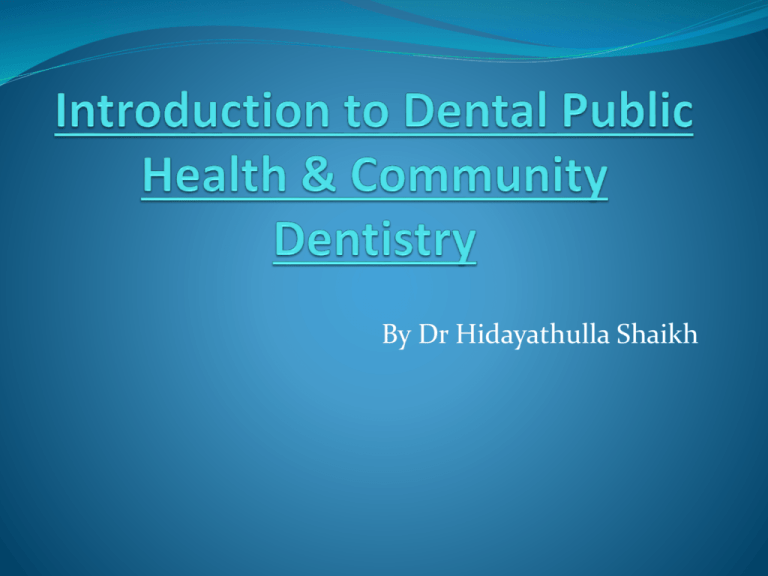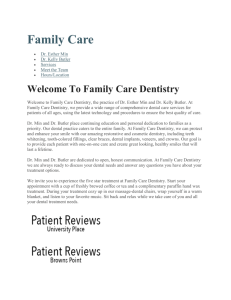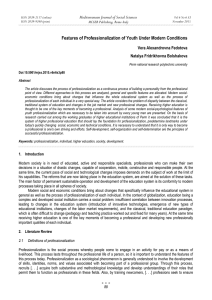Introduction to Dental Public Health & Community Dentistry
advertisement

By Dr Hidayathulla Shaikh Objectives At the end of lecture student should be able to Know what is Dental Public Health Define Health Mention functions of Public Health Dentist Enumerate stages in public health and clinical practice INTRODUCTION • From the earliest times ancient Egyptians used a variety of remedies to treat the diseases of the mouth. • Prevention of oral diseases dates back to the period of Hippocrates. • Dentistry became more organized as a profession due to the effort of many individuals, associations and regulations in the later part of the 19th century. HISTORY OF DENTISTRY Stages of Evolution of Dentistry Stage I Stage II Stage III Stage IV Stage V : : : : : Undifferentiated occupation Differential occupation Initial professionalization Intermediate professionalization Advanced professionalization Stages I: Undifferentiated occupation. In this stage, diseases of teeth were abandoned to their own courses.. A few individuals devote some time to the performance of simple dental operations by simple methods. StageII:Differential occupation: Indigenous practitioners emerged in this stage, without any type of formal training, who devotes entire time for the practice of dentistry. There was no restriction by the government for the practice of dentistry. Stage III: Initial professionalization: Dentists formed an association, organize a course of formal training for a period of 6 months to 2 years. It is in this stage profession comes into being. Restrictive legislation is enacted in the interest of the people at large. Stage IV: Intermediate professionalization. Independent dental schools are established with increased course duration with the minimum requirement for admission being secondary education Stage V: Advanced professionalization. Dentistry becomes recognized as a health profession with an increasing emphasis on biological sciences. Dentistry becomes strongly organized and institutionalized. Postgraduate education develops into number of dental specialties. Dental practice by unqualified personnel disappears. Definition of Health “Health is a state of complete physical, mental and social well being and not merely an absence of disease or infirmity” What Dental Public Health Does: • Prevent epidemics and the spread of disease • Protect against environmental hazards • Prevent injuries • Promote and encourage healthy behaviors and mental health • Respond to disasters and assist communities in recovery • Assures the quality and accessibility of health services STAGES OF PRACTICE. CLINICAL AND PUBLIC HEALTH Individual clinical practice Public health Practice Examination Assessment of need Diagnosis Analysis of data Treatment planning Program planning Informed consent for planning Ethics and planning approval Appropriate mix of care, cure Program implementation and prevention. Payment for services Evaluation Types of finance Appraisal and review. SCIENCE AND DISCIPLINES UNDER DENTAL PUBLIC HEALTH Epidemiology. Health promotion. Biostatistics. Sociology and Psychology. Health Economies Health services management and planning. Demography. AIMS AND OBJECTIVES IN PLANNING DENTAL CARE • To establish rapport by listening and talking to the patient. • To define patient’s requirements by taking case history. • To make a diagnosis and prognosis by means by case history, examination and investment. • To plan a comprehensive treatment tailored according to the status and needs of the patient. • To organize the care to be provided by listing the needs in a logical sequence and referral as appropriate. • To established that patient has achieved a state of dental stability and to plan periodic recall and re evaluation. Functions of Public Health Dentist 1) Program administration 2) Preventive, Diagnostic and Corrective services 3) Program promotion and consultative services 4) Public health training and teaching 5) Dental health education and information 6) Research and study projects. CONCLUSION •Dentistry is in the state of flux witnessing the growth of the profession from the stage of undifferentiated profession to advanced professionalization. •New concepts are accepted in place of the old dogmas. • Advancement in material and technology has made treatment more conservative and aesthetic but comes at a cost that a few can afford. •Profound changes are needed not only in the type of care offered but also in the way providers are trained, employed, supervised and supported to face the challenges in oral health in the new millennium. Evaluation pattern Type Distribution Percentage In course continuous assessment Behavior & Attitude 5% Research 3% Home work 2% Presentation 2% Quiz 3% Practical Assessment 25% Midterm Written Exam 20% 60 Final Exam Final Written Exam 30% Final Practical Exam 10% Total 40 100 Books to be referred: 1. S.S. Hiremath. Text Book of Preventive and Community Dentistry. 2nd edition, 2007. 2. Soben peter. Essentials of Preventive and Community Dentistry, 2nd edition. 3. K Park, Text Book of Preventive and Social Medicine, 23rd edition.





